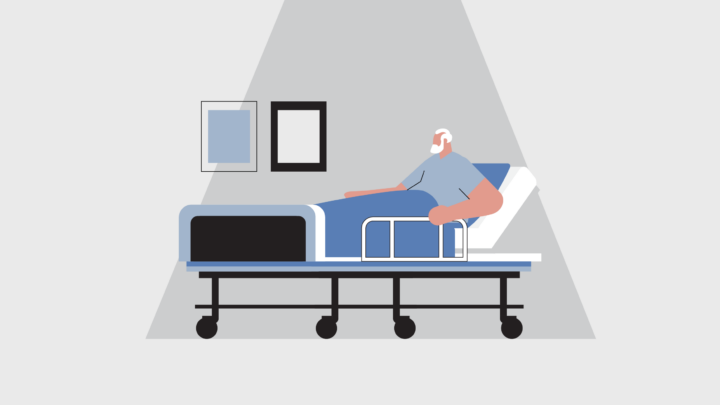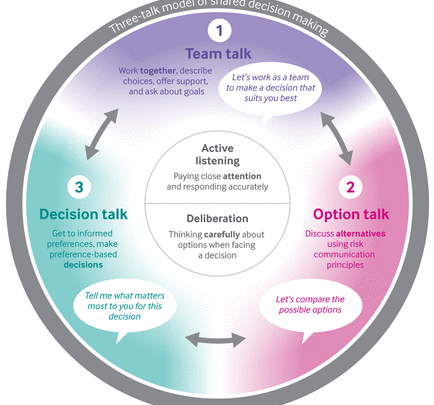
Why patient satisfaction in healthcare should be the #1 concern of physicians
Patient satisfaction is a highly subjective metric that nonetheless plays an important role in the medical care landscape. This satisfaction is rarely just about the treatment results, it’s about the process.
From the moment a patient first contacts a physician, they begin building a relationship. Collective insights from the Sermo community confirm that the success of this relationship depends heavily on the doctor, not the patient.
One US physician on Sermo shares, “Seize every one of them [moments with the patient], even if they are moments of misery, as opportunities to show how good you and your practice are. This will go a long way in building long-term patient loyalty and improve patient satisfaction scores and may even improve compliance and outcomes. Manage every moment! These are the interactions that make our patients say, “I’ll be coming back!”
An unsatisfied patient isn’t just a lost revenue opportunity. Such patients often don’t follow the physician’s recommendations and lose a chance at a successful outcome. Meanwhile, they contribute to negative word-of-mouth marketing.
Improving patient satisfaction in healthcare is a complex but compulsory process. It involves significant investments, both financial and emotional, but also brings an impressive ROI. Understanding where to get started can help you build a comprehensive satisfaction improvement strategy.

Defining patient satisfaction & why you should care
Patient satisfaction is a metric that defines how happy a patient is with the care provided by the physician. High patient satisfaction means that the healthcare provider met all patient expectations regarding care and communication. Factors that contribute to patient satisfaction are:
- Quality of medical treatment
- Ease of access to services
- Staff responsiveness
- Level of empathy provided by healthcare professionals
A satisfied patient usually follows the physician’s recommendations, returns for follow-ups, and recommends the doctor to their friends. Measuring patient satisfaction helps physicians identify areas for care improvement and build positive healthcare relationships.
A GP on Sermo notes, “Some complaints will of course be left about factors outside of our control, but others may highlight areas of weakness and potential opportunity for improvement from the patient’s perspective (which can be quite different to ours as service providers!”
Bottom line: While experience focuses on objective factors, satisfaction is subjective. Great patient experience leads to higher patient satisfaction.
Here’s why doctors should work on improving patient satisfaction:
Higher loyalty and retention
When patients feel valued, they are more likely to stay with the same doctor for a long time. A recent study published in Malahayati International Journal of Nursing and Health Science demonstrated the direct effect of patient satisfaction on patient trust, which in turn led to patient loyalty.
When doctors consistently meet expectations, patients develop long-term relationships with their providers. This loyalty leads to a stronger patient base over time.
Increased profitability
Satisfied patients are not only more likely to return but also more likely to refer others. Positive word-of-mouth can bring in new patients and reduce the need for expensive marketing efforts. 46% of doctors on Sermo said that patient referrals are the most effective marketing strategy for medical practices.
However, word-of-mouth marketing works both ways. An unsatisfied patient is more likely to leave a negative review and describe the experience to friends, family, and co-workers.
According to the Technical Assistant Research Programs (TARPs), one satisfied customer will share their positive experience with four others. Meanwhile, one unhappy customer reaches out to 10 or more people.
Fewer incidents of reimbursement withholding
Healthcare providers are increasingly evaluated based on patient satisfaction scores. Low satisfaction ratings may result in withheld reimbursements from insurers or government programs like Medicare.
Improved staff morale
A positive patient experience doesn’t just benefit the patient, it also improves workplace morale. When patients appreciate the care they receive, they treat staff with more respect. This contributes to a more pleasant work environment and job satisfaction, leading to more productivity and less likelihood to experience burnout.

Better reputation
A physician’s reputation is built on patient experiences. Online reviews, referrals, and overall community perception play a huge role in attracting new patients. High patient satisfaction leads to better reviews and a stronger professional image.
Better outcomes
When patients feel heard and respected, they are more likely to follow medical advice. This directly contributes to better health outcomes. Accordingly, improving patient satisfaction isn’t just about making patients happy, it’s about keeping them healthy.
The 5 P’s of patient satisfaction
The 5 P’s model can be used to enhance various aspects of medical care, including patient satisfaction. They describe issues a physician should focus on outside of the treatment process.
Pain
Pain has the highest impact on the patient’s quality of life. Even if pain is part of mandatory treatment, it affects the patient’s experience and satisfaction. That’s why addressing the patient’s comfort should always be the top priority. Besides assessing pain levels regularly, a physician should make sure the patient feels heard when discussing the pain symptoms.
Position
When it comes to medical procedures, a patient’s physical position plays a significant role in their comfort. The medical staff should pay extra attention to adjusting this position to prevent discomfort. Since the problem isn’t always obvious, the physician should always take a proactive approach.
Personal needs
Hydration, nutrition, hygiene, and restroom access are basic patient needs. Even small actions like offering water or arranging assistance to use the restroom significantly impact patient experience and, in turn, satisfaction.
Proximity
The responsiveness of healthcare staff is a direct patient satisfaction factor. Patients should feel that help is within reach whenever they need it. This help can range from a call button in a hospital room to a timely response from the clinic’s administration. The goal is to make patients feel important and cared for.
Patient education
Patient education is key to making them feel more confident. A physician should provide a clear, jargon-free explanation of all issues related to the patient’s health. When patients understand their health better, they are more likely to follow medical advice and feel satisfied with the care.
7 tactics to improve patient satisfaction
Patient satisfaction improvement often requires minor tweaks to your work. Many physicians are already implementing some of these tactics but lack a more comprehensive strategy. Combining all these recommendations can help reinvent patient relationships and drive satisfaction.

1. Set and manage expectations
From the first visit, physicians should explain treatment plans, recovery timelines, and potential challenges to the patients. Patients who know what to expect are less likely to feel dissatisfied about their care.
2. Emphasize communication
Effective communication goes beyond explaining medical terms. Physicians should actively listen while showing empathy. Simple acts like maintaining eye contact and summarizing key points make patients feel heard.
3. Be responsive
Responsiveness is one of the most important elements that contribute to patient satisfaction. When a doctor doesn’t respond within a reasonable time, a patient feels anxious. This is especially important when it comes to sharing test results.
Telemedicine has helped solve many of these problems. These key telehealth insights from the Sermo community can help you to optimize your responsiveness.
4. Maintain a clean practice
For a patient, clean means safe. A cluttered office with questionable floor cleanliness is likely to turn the patient away. And it’s not just related to the exam rooms – waiting areas, hallways, and restrooms should also be clean and well organized.
5. Discuss pain management
Even when pain is unavoidable, discussing it openly reassures patients. Physicians should acknowledge discomfort and provide pain relief options. Regular check-ins about the patient’s discomfort can go a long way toward satisfaction improvement.
6. Be on time
Respecting patients’ time demonstrates professionalism. While emergencies happen, keeping delays minimal reduces frustration.
Studies show that subjective wait times affect patient satisfaction directly. That’s why keeping the patient informed about the delay and making their wait more comfortable can help boost satisfaction.
Failing to be on time often stems from a poor work-life balance, which 37% of physicians experience today. Improving it could be a great starting point. Taking the “put the mask on yourself first” approach always works best.
7. Dress to impress
First impressions matter. A physician’s appearance should reflect professionalism and competence. Well-groomed attire reassures patients that they are in capable hands.
Patient satisfaction metrics you should measure
Following patient satisfaction metrics is an integral part of your successful practice management process. These metrics can help you monitor your patient improvement strategy and make tweaks in real time.
“Our patient satisfaction is focused on [a] communication metric for hospitalists. I don’t mind this metric. This seems to be a fair, patient-oriented metric since the temptation as a hospitalist is to be brief in order to achieve “round and go”. In addition to my own ethics, this metric helps keep me and my colleagues accountable. My concern is when other metrics that are outside of my control are used to measure my care and determine my livelihood.” – Pediatrician on Sermo
Net Promoter Score (NPS)
NPS measures how likely a patient is to recommend a physician or healthcare facility to others. A high NPS indicates strong patient loyalty, while a low score signals dissatisfaction that could harm retention. NPS questions could be an excellent addition to effective patient satisfaction surveys.
A GP on Sermo notes, “I think the value of feedback surveys comes not from the positive / negative ratio, but from the free text comments patients can leave.”
Patient Effort Score (PES)
This metric assesses how easy it is for patients to access care, schedule appointments, and receive information. The less effort the patient has to make, the higher the satisfaction.

Patient Satisfaction Score (PSS)
PSS is a direct measure of how happy patients are with their care. Surveys assess various factors like provider communication, wait times, and treatment quality. High scores correlate with better patient trust.
According to a Sermo Survey, 41% of physicians believe that implementing patient satisfaction surveys has a positive impact on the healthcare industry.
Patient retention vs. patient churn
Tracking retention rates helps determine whether patients return for ongoing care or switch providers. A high churn rate suggests dissatisfaction, while strong retention indicates a loyal patient base.
Revenue growth
Satisfied patients lead to more referrals and higher retention. This has a direct effect on revenue growth. Measuring financial impact helps physicians see the business value of improving patient experiences.
First Call Resolution (FCR)
FCR measures how often patient inquiries or concerns are resolved on the first contact. High FCR reduces frustration and boosts confidence in the provider’s efficiency.
Time to resolve
This metric tracks how quickly patient concerns, complaints, or requests are addressed. Faster resolutions contribute to higher trust and satisfaction.
Improving patient satisfaction with Sermo
Patient satisfaction is a combination of a professional medical approach and marketing tactics. Without a strong patient satisfaction strategy, it can be hard to stay ahead of the competition and achieve excellent patient outcomes.
While patient surveys provide one perspective, physician surveys and collaboration among physicians also offer valuable insights into the strategies doctors use to improve patient satisfaction.
The Sermo community can help you build a robust patient satisfaction strategy and support you throughout your journey toward high patient satisfaction. Connect with global physicians who excel in patient satisfaction practices and learn from their experiences.













